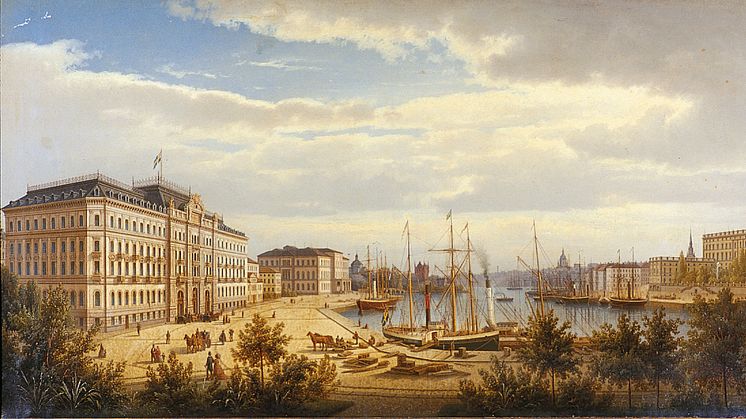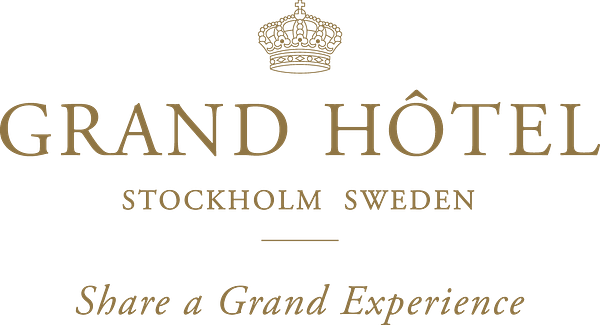
Blog post -
A historical walking tour in the spirit of Régis Cadier
The young, French chef Régis Cadier had no intentions to stay longer than necessary in Stockholm when he first came here with his employer Russian Ambassador Count Dashkov in 1852. When he arrived, on a grey and rainy day in November, the general impression in his home country of Sweden as an inhospitable place in the north was quite accurate to him. Although, it would turn out that Cadier would not only spend the rest of his life in this country, but also have a monumental impact on its hotel- and restaurant scene.
We would like to take you with us on a journey through some of the parts of Stockholm where Cadier left his prints during his time in the city. For a perfect finish, make sure to visit the Cadier bar at the Grand Hôtel and try out our rewarded cocktail menu inspired from Cadiers adventures abroad.
The Cadier family had been running hostelries since the 17th century in the Alps. Cadier was naturally involved in the family business but continued working and educating himself as a kitchen boy in Grenobles, and then moved on to Paris to study the art of high cuisine. He earned his skills at the exclusive restaurant Trois Fréres Provencaux in the Palais-Royal, where he became the executive chef within just a couple of years, cooking for well-known guests like Robespierre and Napoleon Boneparte. His reputation got him the offer to work for the Russian Count Dashkov in St. Petersburg. Shortly after he came to St. Petersburg, far away from his beloved Paris, the count was to be moved to Stockholm.
Skeppsbrokajen
The steam ship Furst Menschikoff has sailed from St. Petersburg to dock here at Skeppsbrokajen on 3rd of November 1852, leaving the servant staff to prepare for Dashkov’s later arrival. Isn’t it funny that this is where Cadier sets foot in Sweden for the very first time, and that he later establishes his life’s work just across the water?
Fersen Palace
When the Russian count and ambassador arrives, this is where he takes up residence with his family and the staff. The kitchen, located on the ground floor, is ruled supreme by Cadier. Accompanying the delegation from Russia is the young Estonian Caroline Roberg, called Lilly for short. She is Countess Dashkov’s lady’s maid. Lilly and Cadier soon take a liking to each other and are later married.
The Royal Palace
Cadier’s employment with the Dashkovs only lasts about a year, partly due to his own ambitions but also because of the deterioration in Franco-Russian relations at the time. A French chef in the Russian delegation is no longer suitable, and Cadier needs no time to consider his answer when he’s offered the prestigious position as royal chef at the Royal Palace in Stockholm. During this time, he will become close friends with King Oscar I and his family – which will turn out to have a huge impact on his future career.
Fredsgatan 24
In 1854 Cadier opens the doors to his new “charcuterie shop”, while he continuously assists the court’s kitchen when needed. Thanks to his polished French manners and courteousness toward his customers, Cadier manages to increase the Stockholmers’ interest in delicatessens. This is also where Sweden’s very first female charcutier is hired.
Fredsgatan 13
The Russian Czar dies in 1855 and shortly after, the Russians capitulate in the Crimean War. Although Sweden has kept a neutral stand in the Crimean War, there is a certain loyalty to France because of the Royal family’s connection. Therefore, the French triumph is celebrated in every possible way and business is good for Cadier. At this time, Régis and Lilly Cadier moves to a big, beautiful apartment at Fredsgatan 13 where they also have their first daughter, Olga.
Gustav Adolfs Torg 12
A scent of Paris has reached the Nordic capital. In 1857 Cadier opens the first restaurant in Stockholm that bears a truly French stamp. He also borrows the name Trois Fréres Provencaux from his old workplace in Paris, and it rapidly grows into an absolute favourite amongst the city’s gastronomes. Fun fact is that at this restaurant, the Stockholmer’s for the very first time get to experience being served one table napkin each as they are seated.
Hotel Rydberg
At the Gustav Adolfs Torg between Malmtorgsgatan and Regeringsgatan, Régis Cadier takes his first steps into the hotel business. During spring 1859, he takes over what at the time is the leading hotel in Stockholm - Hôtel Rydberg. When Cadier is finished with his touch on the hotel, it’s not like anything the Swede’s have ever seen before. It has even been said that not even the Royal Palace can compete with its luxury.
Pohlsro
For a long time Djurgårdsslätten has been the city’s favourite venue for summer entertainment. Cadier buys an old café once opened by court confectioner Johan Fredrik Pohl. Cadier has wanted to offer his guests something as a complement to the Hôtel Rydberg, and therefore develops the café into a successful restaurant. Two years later his good old friend Francois Vasseur takes over. Monsieur Cadier has set his eyes on his next goal.
Blasieholmen
In 1860, Stockholm is promoted as the “Paris of the North” and it is obvious that one deluxe hotel simply isn’t enough to accommodate both international and Swedish guests in the capital. Cadier has regularly visited his hometown and recently witnessed the uprising of Paris’ Grand Hôtel – with 800 rooms and 250 servants. No other public building in Paris represents the city at this time as magnificently as this. And Cadier returns to Stockholm, immensely inspired. He seeks out three significant lots, located at the Södra Blasieholmshamnen, where he aims to establish his most important project so far. Two of the lots are sold to Cadier shortly, for 230 000 Swedish kronor. He turns to architect Mr. Axel Kumlien and in March 1872, the work has started to raise Stockholms first grandiose hotel.
Sunday, 14th of June 1874, King Oscar II and three of his sons arrive to the newly built Grand Hôtel. Cadier himself gives the Royal family a guided tour. The day after, the official opening takes place, and the news reaches not only Sweden and Europe, but also the US. The newspapers report about the “magnificent hotel containing 314 rooms” and that the price of these rooms will be “four to seven and a half kronor per day”.
Tivoliparken, Solna
When King Charles XV dies, Cadier is offered the leasehold of “The Russian Villa”, a holiday house in Bergshamra that used to belong to the ambassador family. This becomes a true source of joy for the Cadier family, as they can escape the city and allows them to cope with the hectic work at the Grand and the Hôtel Rydberg. Cadier decides to establish a model farm with a large Pig Sty, and a horticulture farm to supply his hotels with fruit and vegetables all year around. The remains of this can still be seen at the terraces next to Tivolibergets slope towards Brunnsviken.
Bolinderska Palace
15 years after its opening, the Grand Hôtel holds an indisputable position as the leading hotel in Sweden with an international status. Cadier is still keen on a chance to add the third connecting lot to the Grand Hôtel though, that now is owned by the Bolinder brothers. They have made it their mission to transform the building on this lot to the most elegant one in Stockholm, inspired by classic Venetian renaissance style. Sweden’s most foremost architect Helgo Zetterwall is hired for the project, and master-builder Thavenius is responsible for the decorative details, and asks artists like Mårten Eskil and Hanna Winge, Carl Larsson and Gotthard Werner to paint and design the interior. When this is accomplished, Bolinder agrees to sell the building to Cadier. Cadier, Lilly and their children moves in to the second floor, into a 13-room apartment, and Cadier incorporates the rest into the hotel. Nowadays, conferences and banquets are held in these very rooms, named after their designers.
Skansen
Régis Cadier is a true friend of animals and decides to build a large aviary in the main entrance of the Grand Hôtel, where hundreds of small birds fly about freely inside the cage which can be observed also by passers-by on the street. Unfortunately, the twittering causes such a nuisance to the guests that in the end, Cadier removes his winged friends to Skansen, Stockholm’s zoo. Birds are not the only animals living at the hotel at the time, though. Once, Cadier receives a wooden box from St. Petersburg, containing two bear cubs. During their first months, Cadier let the brown bears romp and roll in the hotel lobby to the great delight of his guests. But the bears grow and become more unruly in their frolicking and finally Cadier has no choice but to send them to happier hunting grounds.
Malmstensbutiken
Cadiers niece Carl Malmsten is one of our most beloved designers, and his work is still immensely popular. His shop is located on Strandvägen 5B and was opened officially by Carl Malmsten himself in the 40’s.
The Northern Cemetery, Solna
Régis Cadier dies at age 61, on March 5, 1890 after a short period of illness. The family Cadier has by then lived in the Bolinderska Palace for only one year. The whole of Stockholm is in sorrow. Cadiers closest family takes over the responsibilities for the hotels and Cadiers other businesses he’s developed throughout the years, but only for a short while. When Régis Cadier is dead, and the Grand Hôtel a couple years later is sold, it marks the end of the first, most important stage of the development of the Swedish hotel industry and a new stage is about to begin, in a new century. Régis Cadier is buried in grave no 437 in the ninth section at Solnas churchyards cemetery.
